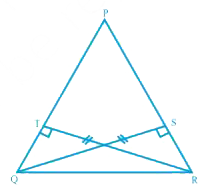In Fig. 6.55,QS⊥PR,RT⊥PQ and QS = RT.
 (i) IsΔQSR≅ΔRTQ? Give reasons. (ii) Is ∠PQR=∠PRQ? Give reasons.
(i) IsΔQSR≅ΔRTQ? Give reasons. (ii) Is ∠PQR=∠PRQ? Give reasons.
Step by step video & image solution for In Fig. 6.55, QS ⊥ PR, RT ⊥ PQ and QS = RT. (i) Is ∆ QSR ≅ ∆ RTQ? Give reasons. (ii) Is ∠ PQR = ∠ PRQ? Give reasons. by Maths experts to help you in doubts & scoring excellent marks in Class 7 exams.
Updated on:21/07/2023Topper's Solved these Questions
Similar Questions
In Figure, PQ = PS and ∠1=∠2.

(i) Is ΔPQR≅ΔPSR? Give reasons.
(ii) Is QR = SR? Give reasons.
View SolutionIn the given figure, QS⊥PR,RT⊥PQ and QS =RT

Is △QSR=~△RTQ? Give reason.
(ii) Is ∠PQR=∠PRQ? Give reason.
View Solution
(i) Identify A and B.
(ii) What is the role of B ? Give reasons why it is in C?
(iii) Explain the given system.
View SolutionIn the figure, AB=AD and BC=DC (i) State three pairs of equal parts in △ABC and △ADC (ii) Is △ABC≅△ADC? Give reasons (iii) Does AC bisect ∠BAD? Give reasons
View SolutionIn ΔPQR of Fig. 6.32, PQ = PR. Find the measures of ∠Qand∠R.

View SolutionSF6 is known but SC6 is not. Why?
View SolutionA and B are respectively the points on the sides PQ and PR of a ΔPQR such that PQ =12.5 cm, PA= 5 cm, BR = 6 cm and PB = 4 cm. Is AB || QR? Give reason for your answer.
View SolutionIn Fig. 6.15, angle PQR= angle PRQ, then prove that angle PQS= angle PRT.
View SolutionIn Fig. (ii), AD = BC and AD || BC. IS AB = DC? Give reasons in support of your answer.Hint. Prove that △ABC=△CDA.
View SolutionCopper (I) is diamagnetic while copper (II) is paramagnetic . Explain.
View Solution
